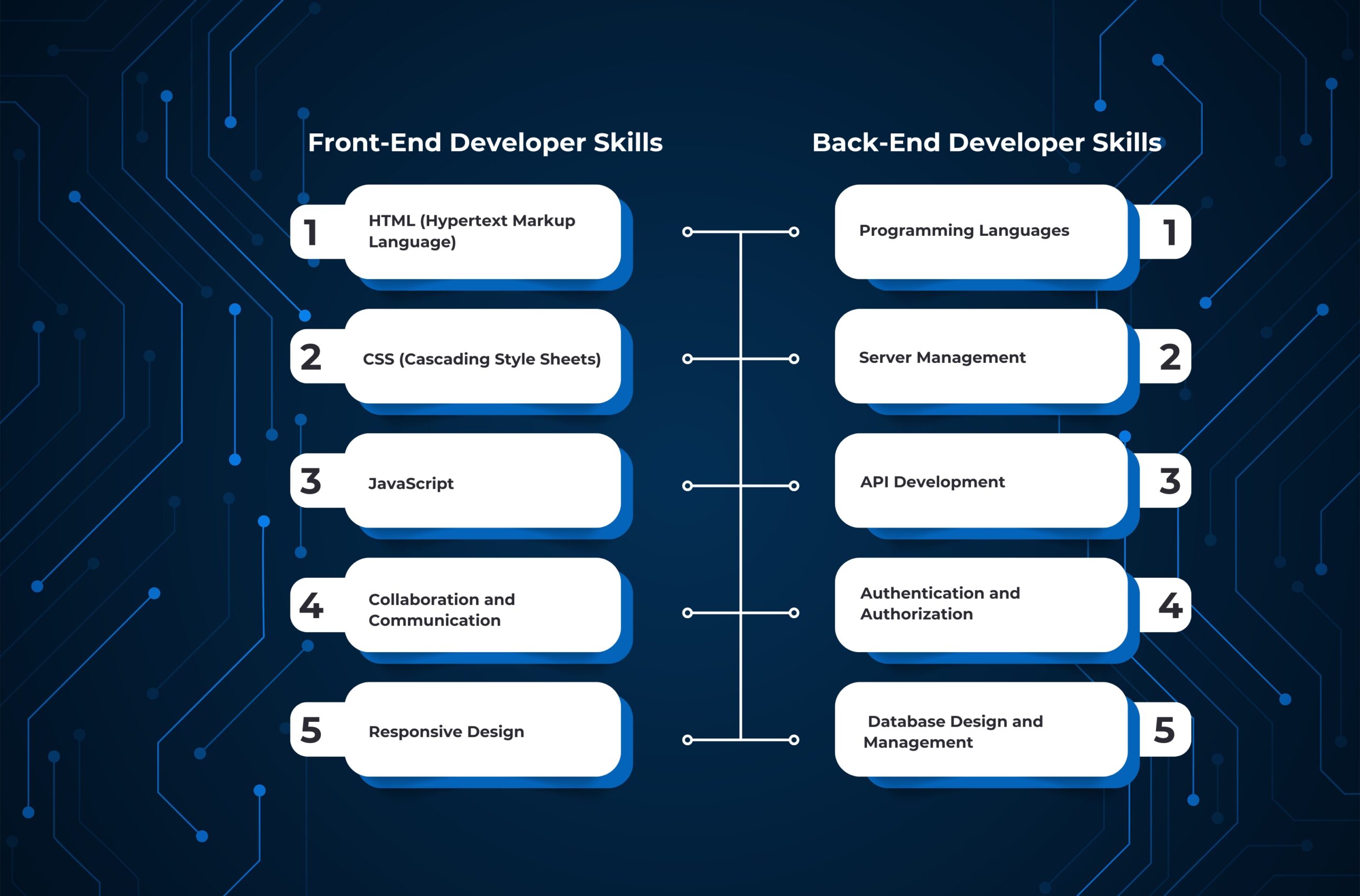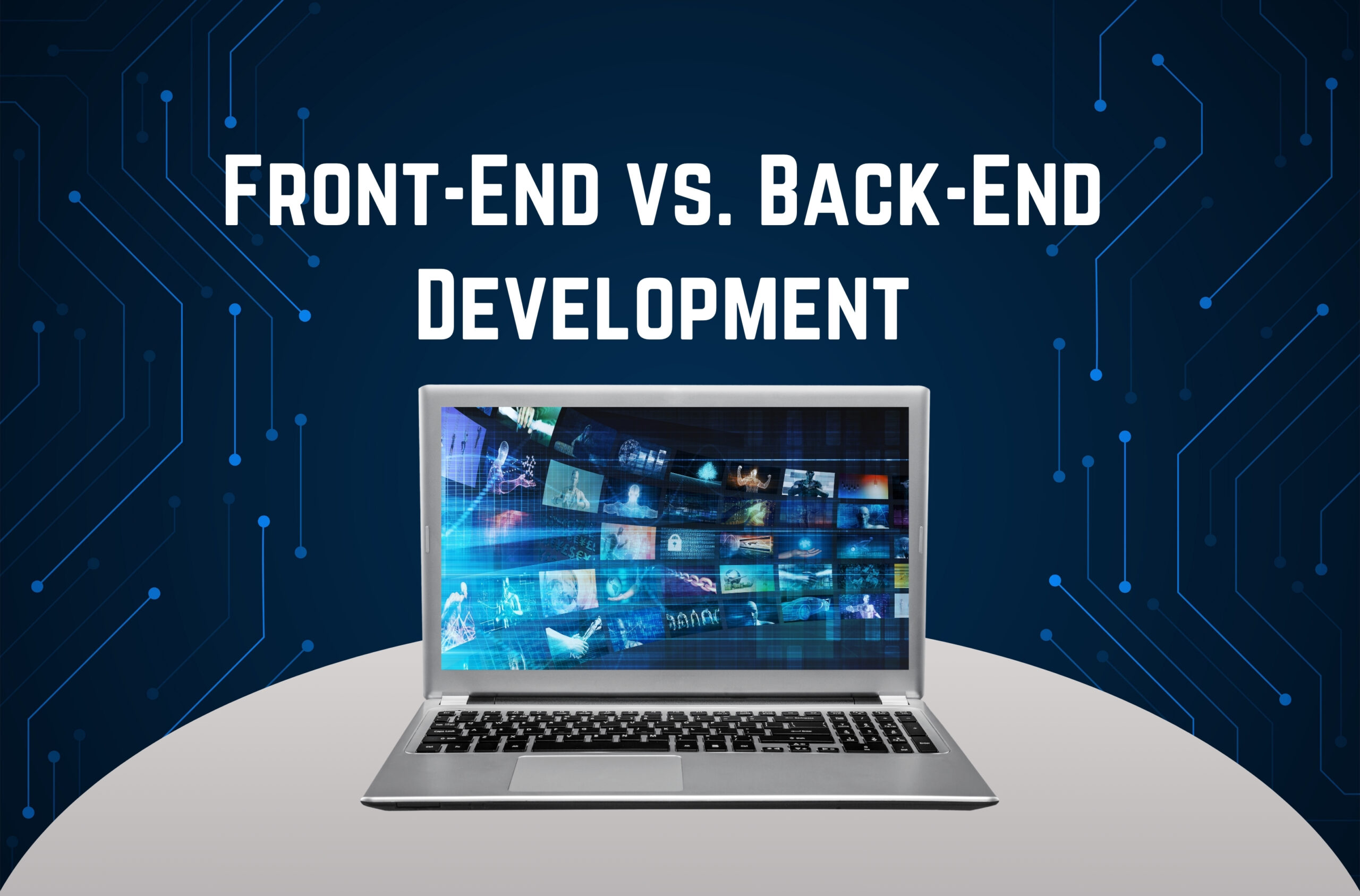Websites consist of two parts: the front end vs. Back end development. While they might sound self-explanatory, understanding the nuances of their roles and the technologies they involve is essential for anyone looking to dive into the world of programming and development. In this blog, we will discuss the differences between Front-End and Back-End Development.
Contents
What Is Front-End vs. Back-end Development?
Front-end development, often referred to as client-side development, is the practice of creating the user interface and user experience that end-users interact with directly. It involves designing and implementing the visual aspects of websites and applications, including layout, colors, typography, buttons, and interactive elements.
Front-end developers are responsible for bringing to life the designs created by UX/UI designers. They use technologies like HTML (Hypertext Markup Language), CSS (Cascading Style Sheets), and JavaScript to build responsive and visually appealing interfaces. HTML structures the content, CSS styles it and JavaScript adds interactivity and dynamic behavior.
Modern front-end development has evolved significantly with the advent of various frameworks and libraries. Frameworks like React, Angular, and Vue.js provide developers with tools to efficiently manage complex user interfaces and update components without reloading the entire page. These tools facilitate the creation of Single Page Applications (SPAs), where content updates occur seamlessly.
Front-End Developer Skills:
Front-end developers play a crucial role in creating visually appealing and user-friendly interfaces for websites and applications. To excel in this role, they need a combination of technical skills, design sensibilities, and the ability to work collaboratively. Here are some essential skills for front-end developers:
1. HTML (Hypertext Markup Language):
Proficiency in HTML is a fundamental skill for front-end developers. They should be able to create structured content and understand semantic HTML to ensure proper accessibility and SEO.
2. CSS (Cascading Style Sheets):
Strong knowledge of CSS is essential for styling web content. Front-end developers should understand layout techniques, responsiveness, and how to use CSS pre-processors like Sass.
3. JavaScript:
A solid grasp of JavaScript is crucial for adding interactivity and dynamic behavior to web pages. Knowledge of ES6+ features, DOM manipulation, and asynchronous programming is important.
4. Collaboration and Communication:
Front-end developers often collaborate with designers, back-end developers, and other team members. Strong communication skills and the ability to work in a team are crucial.
5. Responsive Design:
Front-end developers need to ensure that websites and applications work well on various devices and screen sizes. They should be familiar with responsive design principles and media queries.
6. Cross-Browser Compatibility:
Ensuring that web pages function correctly across different browsers is a key responsibility. Front-end developers should be familiar with browser compatibility issues and how to address them.

What is Back-End Development?
Back-end development, on the other hand, focuses on the server side of applications. It involves building and maintaining the servers, databases, and application logic that operates behind the scenes. Back-end developers handle data storage, retrieval, and manipulation, as well as managing user authentication and the overall application functionality.
While users interact with the front end, the back end ensures that the right is delivered to the front end and that user inputs are processed correctly. It involves working with databases like MySQL, PostgreSQL, or NoSQL options like MongoDB. Back-end developers also use programming languages like Python, Ruby, Java, PHP, and frameworks like Ruby on Rails, Django, or Node.js to create the necessary logic.
Security is a significant concern in back-end development. Developers need to protect user data, prevent unauthorized access, and secure communication between the front-end and back-end components. This involves implementing encryption, and authentication protocols, and adhering to best practices to safeguard sensitive information.
Back-End Developer Skills:
Back-end developers are responsible for creating and maintaining the server-side logic, databases, and infrastructure that power websites and applications. To succeed in this role, they need a combination of programming skills, database management knowledge, and an understanding of server architecture. Here are some essential skills for back-end developers:
1. Programming Languages:
Back-end developers often work with languages like Python, Ruby, Java, PHP, Node.js, and C#. Proficiency in at least one of these languages is crucial for implementing server-side logic.
2. Server Management:
Understanding how to set up, configure, and manage servers is essential. Familiarity with server technologies like Apache, Nginx, and deployment platforms like Heroku or AWS is beneficial.
3. API Development:
Back-end developers often create APIs (Application Programming Interfaces) to allow communication between the front-end and back-end components. Understanding API design principles and RESTful architecture is important.
4. Authentication and Authorization:
Back-end developers should know how to implement user authentication and authorization mechanisms to control access to different parts of an application.
5. Database Design and Management:
Designing efficient database structures and managing data consistency, indexing, and migrations are critical skills for back-end developers.
6. Command Line Usage:
Proficiency in using the command line is important for tasks like server management, database operations, and running scripts.
Collaboration and Communication
Front-end and back-end developers need to collaborate closely to ensure a seamless user experience. Communication between these teams is crucial to align designs, functionality, and data flow. Front-end developers rely on back-end APIs (Application Programming Interfaces) to fetch and update data from the server, while back-end developers depend on the front-end to provide a user-friendly interface for end-users.
Full-Stack Developers: Bridging the Gap
In recent years, the term “full-stack developer” has gained prominence. Full-stack developers are proficient in both front-end and back-end development, allowing them to work on all layers of an application. They have a comprehensive understanding of how different components interact and can effectively switch between working on the user interface and the server-side logic.
Conclusion
Front-end and back-end development are two sides of the same coin, working together to create the digital experiences we interact with daily. Front-end developers focus on designing user interfaces and ensuring an enjoyable user experience, while back-end developers handle server-side logic, data management, and security.
Collaboration and communication between these two teams are essential for building successful applications. Whether you’re drawn to the visual aspects of front end or the logic-driven back end, both areas offer exciting opportunities for individuals passionate about creating innovative digital solutions.


